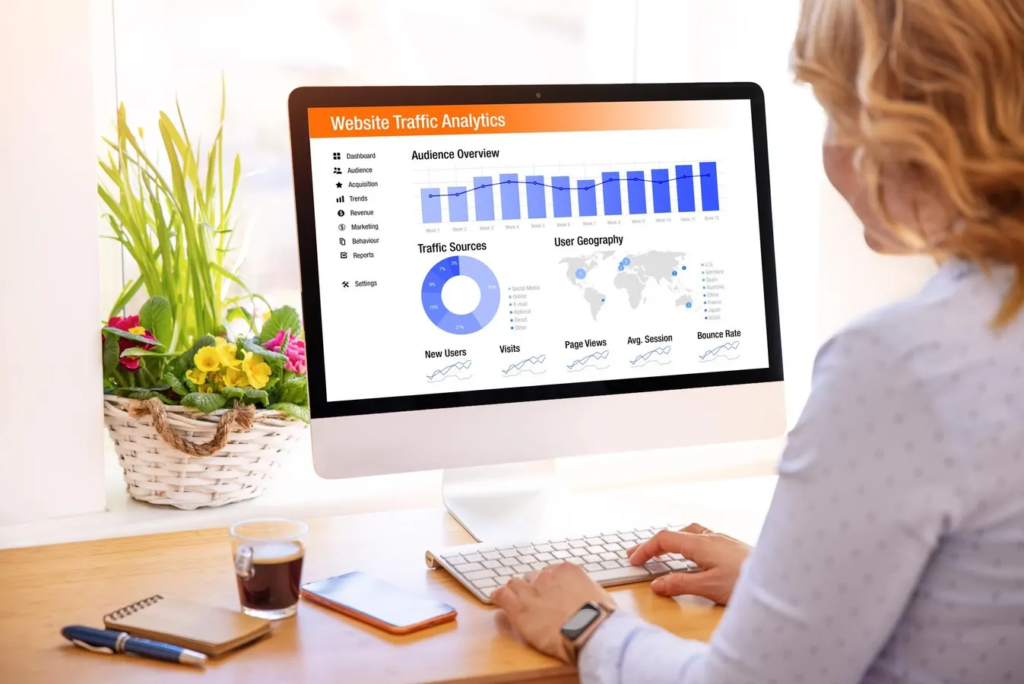Master Website Traffic Tracking and Reporting with a Digital Marketing Course
Understanding and analyzing website traffic tracking is crucial for anyone learning digital marketing or starting a new online business. Tracking website traffic provides invaluable insights into how visitors interact with your site, which is essential for making informed decisions about your marketing strategies and overall business growth.
- Firstly, tracking website traffic helps you understand the effectiveness of your marketing campaigns.
- Secondly, website traffic analysis helps you gain a deeper understanding of your audience.
- Moreover, tracking website traffic enables you to optimize your website’s performance. By identifying high-performing pages and areas where visitors drop off, you can make necessary improvements to enhance the user experience.
Learning to track and analyze website traffic is a fundamental skill in digital marketing. It empowers you to make data-driven decisions, optimize your marketing efforts, and ultimately drive business growth. Whether you’re a beginner or looking to enhance your existing skills, mastering website traffic analysis is essential for success in the digital landscape
Table of Contents
Why Tracking Website Traffic is Essential
Tracking website traffic is akin to having a powerful microscope for your online business. It provides invaluable insights into how your website is performing and helps you make data-driven decisions to improve it. Here’s why it’s crucial:
Understanding Your Audience
- Identify your target audience: Learn who is visiting your website, their demographics, interests, and behavior.
- Tailor content: Create content that resonates with your audience by understanding their preferences.
- Improve user experience: Design your website to meet the needs and expectations of your visitors.
Measuring Website Performance
- Track website traffic: Monitor the number of visitors, page views, and bounce rate to assess overall performance.
- Identify top-performing pages: Discover which content is most popular and why.
- Optimize website speed: Improve loading times to enhance user experience and search engine rankings.
Enhancing SEO
- Keyword research: Identify relevant keywords and optimize your content accordingly.
- Track organic traffic: Measure the effectiveness of your SEO efforts.
- Improve search engine rankings: Make data-driven adjustments to climb higher in search results.
Improving Conversion Rates
- Track user behavior: Understand how visitors navigate your website and identify drop-off points.
- Optimize calls to action: Create compelling CTAs that encourage conversions.
- A/B testing: Experiment with different website elements to increase conversions.
Measuring Marketing Effectiveness
- Track campaign performance: Determine which marketing channels are driving the most traffic.
- Calculate ROI: Evaluate the return on investment for your marketing efforts.
- Optimize marketing spend: Allocate budget effectively based on performance data.
Making Data-Driven Decisions
- Identify trends: Spot patterns in website traffic to anticipate future needs.
- Optimize website structure: Improve navigation and user flow based on data.
- Stay ahead of competitors: Use insights to gain a competitive advantage.
In essence, tracking website traffic is the foundation for a successful online presence. By understanding your audience, measuring performance, and making data-driven decisions, you can optimize your website for growth and achieve your business goals.
Would you like to learn about specific tools for tracking website traffic or how to analyze the data you collect?
How a Course Can Help You Master Traffic Tracking and Reporting

Enrolling in a digital marketing course can significantly enhance your ability to track and report website traffic. Here are some key ways a course can help:
1. Comprehensive Understanding of Tools and Techniques
A digital marketing course provides in-depth knowledge of essential tools like Google Analytics, Semrush, and other analytics platforms. You’ll learn how to set up these tools, configure them according to your needs, and utilize their features to gather detailed traffic data.
2. Practical Application and Hands-On Experience
Courses often include practical assignments and projects that allow you to apply what you’ve learned in real-world scenarios. This hands-on experience is invaluable for mastering the nuances of traffic tracking and reporting, ensuring you can implement these skills effectively in your business.
3. Data Analysis and Interpretation
Understanding raw data is one thing, but interpreting it to make informed decisions is another. A digital marketing course teaches you how to analyze traffic data, identify trends, and derive actionable insights. This helps in making data-driven decisions to optimize your website and marketing strategies.
4. Custom Reporting and Automation
Courses often cover advanced reporting techniques, including creating custom reports and automating data collection and analysis. This ensures you can generate insightful reports efficiently, saving time and reducing the risk of manual errors[6][7].
5. SEO and Content Strategy Integration
A good digital marketing course will show you how to integrate traffic tracking with your SEO and content strategies. By understanding which keywords and content pieces drive the most traffic, you can refine your SEO efforts and content creation to maximize results.
6. Continuous Learning and Updates
Digital marketing is a rapidly evolving field. Courses often provide access to ongoing resources, updates, and communities where you can stay informed about the latest trends and best practices in traffic tracking and reporting.
In summary, a digital marketing course equips you with the skills and knowledge needed to effectively track and report website traffic. This not only helps in improving your website’s performance but also enhances your overall digital marketing strategy.
Tools for Website Traffic Tracking
There are numerous tools available to track website traffic, each with its own strengths and focus. Here are some of the most popular options:
Free Tools
- Google Analytics: The industry standard, offering comprehensive data on user behavior, demographics, and more.
- Google Search Console: Focuses on search engine performance, providing insights into how your site appears in search results.
- Matomo (formerly Piwik): Open-source alternative to Google Analytics, offering privacy-focused tracking.
Paid Tools
- Hotjar: Provides heatmaps, session recordings, and user feedback to understand user behavior.
- Crazy Egg: Similar to Hotjar, with a focus on conversion rate optimization.
- SimilarWeb: Offers competitive analysis and estimates of website traffic.
- Adobe Analytics: Robust enterprise-level analytics platform with advanced features.
- Clicky: Real-time analytics with visitor monitoring and site speed insights.
Other Notable Tools
- FullStory: In-depth session recording and user behavior analysis.
- Mixpanel: Product analytics focused on user engagement and retention.
- Heap: Automatic event tracking for understanding user interactions.
Choosing the Right Tool
The best tool for you depends on your specific needs and budget. Consider the following factors:
- Features: What data do you need to collect?
- Ease of use: How comfortable are you with analytics platforms?
- Cost: What is your budget for website tracking?
- Privacy: Do you have concerns about data privacy?
Would you like to explore specific use cases or compare features of different tools?
Career Opportunities in Website Traffic Tracking and Reporting

Understanding and analyzing website traffic is a crucial skill in today’s digital age. Here are some career paths that leverage this expertise:
Digital Marketing
- Digital Marketing Analyst: Analyze website traffic data to inform marketing strategies, measure campaign performance, and optimize ROI.
- SEO Specialist: Use traffic data to identify keywords, improve search engine rankings, and track organic traffic growth.
- PPC Specialist: Optimize paid advertising campaigns based on website traffic metrics, conversion rates, and user behavior.
- Social Media Manager: Measure the impact of social media campaigns on website traffic and adjust strategies accordingly.
- Email Marketing Specialist: Analyze email campaign performance, track click-through rates, and optimize email content.
Web Analytics
- Web Analyst: Collect, analyze, and report on website traffic data to provide insights into user behavior and website performance.
- Data Analyst: Use statistical methods to analyze large datasets, including website traffic data, to identify trends and patterns.
- Business Analyst: Apply data analysis to inform business decisions, including website optimization, product development, and marketing strategies.
User Experience (UX)
- UX Researcher: Conduct user research and analyze website traffic data to understand user behavior and identify areas for improvement.
- UX Designer: Use traffic data to inform website design and information architecture, creating a better user experience.
E-commerce
- E-commerce Analyst: Analyze website traffic and sales data to optimize product offerings, pricing, and marketing strategies.
- E-commerce Manager: Use traffic data to monitor website performance, identify customer trends, and drive sales growth.
Other Roles
- Product Manager: Utilize website traffic data to understand product performance, customer preferences, and identify new opportunities.
- Data Scientist: Build predictive models using website traffic data to forecast trends, customer behavior, and business outcomes.
In essence, a strong foundation in website traffic tracking and reporting can open doors to various roles across different industries.
Would you like to explore a specific career path or discuss the skills required to excel in this field?
Key Metrics to Focus on When Analyzing Website Traffic
When analyzing website traffic, it’s important to focus on a few key metrics that provide valuable insights into your site’s performance and user engagement. Here are some of the most important metrics to track:
- Traffic Sources: Understand where your website traffic is coming from, such as organic search, referrals, social media, and direct traffic. This helps you allocate resources effectively and focus on the most successful channels.
- Bounce Rate: Track the percentage of visitors who leave your site after viewing only one page. A high bounce rate could indicate issues with content relevance, user experience, or page load speed.
- Conversion Rate: Monitor the percentage of visitors who complete a desired action, such as making a purchase or filling out a form. Optimizing for conversions is crucial for driving business results.
- Pages per Session: Analyze the average number of pages each visitor views during a session. A higher number of pages per session suggests better engagement and content quality.
- Average Session Duration: Track the average time visitors spend on your site. Longer session durations indicate more engaged users and better content.
How Tracking Website Traffic Can Improve SEO
Tracking website traffic is essential for improving your SEO efforts in several ways:
- Identifying High-Performing Content: Analyze which pages and content attract the most traffic and engagement. Use this data to create more of what works well and optimize underperforming content.
- Improving Technical SEO: Monitor metrics like page load speed and crawlability to identify and fix technical issues that could be hindering your SEO performance.
- Targeting the Right Keywords: Use traffic data to understand which keywords are driving the most relevant traffic to your site. Focus on optimizing for these high-value keywords.
- Measuring the Impact of SEO Efforts: Track changes in traffic and rankings over time to measure the effectiveness of your SEO strategy. Adjust your approach based on the results.
“Become an expert with Advanced Digital Marketing Training and start your career growth. Enroll in Upcoming Demo Class! “
Tools for Tracking Referral Traffic
Several tools can help you effectively track referral traffic to your website:
- Google Analytics: Provides detailed insights into referral traffic sources, including the specific pages and websites that are sending visitors to your site.
- Ahrefs: Offers a comprehensive backlink analysis tool that shows you which sites are linking to your content and driving referral traffic.
- Semrush: Includes a referral analytics feature that helps you identify high-value referral sources and analyze the quality of referral traffic.
Using Traffic Data to Optimize Content Strategy
Website traffic data can be a powerful tool for optimizing your content strategy in several ways:
- Identifying Top-Performing Content: Analyze which pages and content attract the most traffic and engagement. Use this data to create more of what works well and optimize underperforming content.
- Targeting the Right Audience: Understand who your target audience is and what type of content they engage with the most. Use traffic data to create more relevant and valuable content for your ideal users.
- Improving Content Promotion: Analyze which channels and tactics are driving the most traffic to your content. Focus on promoting your content through the most effective channels.
- Personalizing Content: Use traffic data to personalize content recommendations and experiences for individual users based on their interests and behavior.
Organic vs. Paid Traffic
Organic traffic refers to visitors who find your website through unpaid search results, while paid traffic comes from visitors who click on ads or sponsored content. Here are some key differences between the two:
- Cost: Organic traffic is free, while paid traffic requires an investment in advertising.
- Sustainability: Organic traffic is more sustainable in the long run, as it doesn’t rely on ongoing ad spend. However, it can take time to build up.
- Targeting: Paid traffic allows for more precise targeting based on demographics, interests, and search intent. Organic traffic is more broad.
- Measurability: Both organic and paid traffic can be tracked and measured using tools like Google Analytics. However, paid traffic provides more detailed data on ad performance.
Skills for Mastering Website Traffic Tracking and Reporting
To master traffic tracking and reporting, it’s important to develop a range of skills, including:
- Data analysis: Ability to interpret traffic data and draw insights from it.
- Reporting: Skill in creating clear and actionable reports that communicate key findings to stakeholders.
- SEO: Understanding of how to optimize websites for search engines to drive organic traffic.
- Digital advertising: Knowledge of paid traffic channels like Google Ads and social media advertising.
- A/B testing: Ability to test different content and design variations to optimize for traffic and conversions.
- Collaboration: Strong communication and teamwork skills to work effectively with other departments like content and design.
Integrating Traffic Tracking into Digital Marketing Strategy
To effectively integrate traffic tracking into your digital marketing strategy, consider the following steps:
- Set clear goals: Define what you want to achieve with your traffic tracking efforts, such as increasing conversions or improving user engagement.
- Choose the right metrics: Select the key metrics that align with your goals and provide the most valuable insights.
- Implement tracking tools: Set up tools like Google Analytics to collect traffic data across your website and marketing channels.
- Analyze and report: Regularly analyze traffic data, identify trends and opportunities, and report findings to stakeholders.
- Optimize and iterate: Use traffic data to optimize your marketing efforts, test new strategies, and continuously improve your results.

Challenges in Tracking Website Traffic and How to Overcome Them
Some common challenges in tracking website traffic include:
- Data accuracy: Ensuring that traffic data is accurate and not skewed by factors like bot traffic or cookie blocking.
- Multi-channel attribution: Accurately attributing conversions to the right traffic sources in a multi-channel marketing environment.
- Data overload: Dealing with the sheer volume of traffic data and identifying the most important insights.
- Lack of context: Understanding the broader context behind traffic data, such as industry benchmarks and user intent.
To overcome these challenges, consider:
- Implementing robust data hygiene practices to ensure data accuracy.
- Using multi-channel attribution models to better understand the impact of different traffic sources.
- Focusing on key metrics and using data visualization tools to identify trends and insights.
- Conducting user research to better understand user intent and context behind traffic data
- Industry Approaches to Traffic Tracking and Reporting
Different industries approach traffic tracking and reporting in unique ways based on their specific goals and challenges:
- E-commerce: Focuses heavily on conversion rate optimization and tracking revenue generated from different traffic sources.
- Media and publishing: Prioritizes engagement metrics like time on site and pages per session to measure the effectiveness of content.
- SaaS: Tracks trial signups and paid conversions from different traffic sources to optimize the customer acquisition funnel.
- Non-profits: Measures traffic to donation pages and volunteer sign-ups to track the impact of fundraising and awareness campaigns.
Latest Trends in Traffic Tracking and Reporting Tools
Some of the latest trends in traffic tracking and reporting tools include:
- Increased focus on privacy: Tools that prioritize data privacy and comply with regulations like GDPR and CCPA.
- Artificial intelligence and machine learning: Tools that use AI to automate data analysis and provide actionable insights.
- Omnichannel tracking: Tools that provide a unified view of traffic across multiple channels and devices.
- Predictive analytics: Tools that use historical data to predict future traffic trends and opportunities.
- Customizable dashboards: Tools that allow users to create personalized dashboards and reports based on their specific needs.
By focusing on these key metrics, leveraging the right tools, and continuously optimizing your approach, you can effectively track and analyze website traffic to drive better results for your business.








